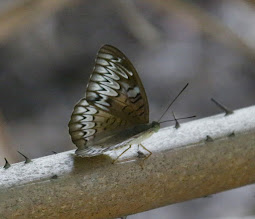For this October there were three rare ones seen. Some were straight forward while some need close observation before one can verify their existence. Here is the first one.
Koh-i-Noor (Amathuxidia amythaon dilucida)
This is a male. Saw its bluish and white band upperside when it flew off. It is reported to be rare probably due to its cryptic personality and its sensitivity towards human presence. I was lucky to get some photos of it before it flew away. Also thanks to a fellow butterfly enthusiast who alerted us of its presence.
When I first saw it, it perched quite low and partially hidden by some bushes. So I quietly moved to a higher ground so that I could get a full view of it. Very happy to finally get my target species after so many years.
Here is a rare skipper with a rather unusual scientific name. My 'lifer' # 338.
Ge geta (Circular Tufted Demon)
Three pertinent field marks can be seen here which points them to the species:
1) Long antenna, 2) Smaller hyaline spots and 3) Darker underside.
The third rare one is also another skipper.
White-tipped Palmer (Lotongus calathus calathus)
It perched nicely for this shot.
White-tipped Palmer (Lotongus calathus calathus)
If you may have noticed the other subspecies i.e Lotongus avesta - it has two small spots at its forewing apex area which are absence in the above species.
Arhopala species are difficult to identify but with the help from experienced butterfly spotters you can actually confirmed their respective ID.
This is a Broad Yellow Oakblue (Arhopala amphimuta amphimuta).
The above species was identified from the "V" shape at its lower arm as indicated above. Reported to be a common butterfly by CP5 but I hardly come across it.
Here is a 'Neptis' which would need closer examination to positively ID it.
This is a Neptis harita harita (Moore) aka Chocolate Sailor. One of its important feature is the little protrusion on its forewing band as indicated above.
An underside view of a Chocolate Sailor
I saw two of them.
Here is a comparison of two female Tanaecia.
Horsfield's Baron (Tanaecia iapis iapis) Malayan Viscount (Tanaecia pelea pelea)
Other than their forewing markings, Tanaecia iapis iapis is slightly larger in appearance than T. pelea pelea.
Here are a few tiny butterflies which I came across during my trip to a mangrove area in Penang.
Gram Blue (Euchrysops cnejus cnejus)
Looks like this species is more common in the northern region of Peninsular Malaysia.
Gram Blue
Gram Blue
The next butterfly below here is even more tiny.
Lesser Grass Blue (Zizinia otis lampa)
Lesser Grass Blue (Zizinia otis lampa) - Female
All were seen at a flat grass land near the mangroves.
Now back to the jungle species.
This is a Large Long-branded Flitter (Isma umbrosa umbrosa)
Quite common it seems.
Common Bush Brown (Mycalesis janardana)
The Knight
Prosotas nora superdates caught in flight
Common Line Blue
Along side with Rustic (Cupha erymanthis), you would most likely also find a Junonia on a bright sunny day.
Chocolate Pansy (Junonia hedonia)
Tawny Rajah (Charaxes bernadus)
Tawny Rajah is reported to be uncommon but at its favourite locations, it can be quite common.
Common Hedge Blue (Acytolepis puspa lambi)
One of the better photos I have taken on this species.
Common Hedge Blue (Acytolepis puspa lambi)
IT'S ALMOST YEAR END ! HOPE TO SEE MORE NEW BUTTERFLIES !





























No comments:
Post a Comment